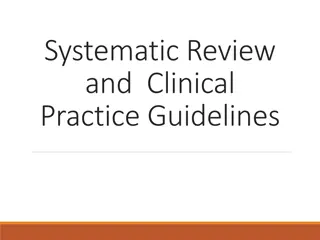Comprehensive Overview of Admetan: A New Meta-Analysis Command
This meta-analysis command, Admetan, introduced by David Fisher from MRC Clinical Trials Unit at UCL, offers a comprehensive analysis of combining results from independent studies. It builds on the history of meta-analysis in Stata and aims to enhance capabilities for researchers. Admetan provides functionalities similar to Metan but with potential improvements, promising better forest plots and enhanced defaults.
Download Presentation

Please find below an Image/Link to download the presentation.
The content on the website is provided AS IS for your information and personal use only. It may not be sold, licensed, or shared on other websites without obtaining consent from the author. Download presentation by click this link. If you encounter any issues during the download, it is possible that the publisher has removed the file from their server.
E N D
Presentation Transcript
admetan A new, comprehensive meta- analysis command David Fisher MRC Clinical Trials Unit at UCL 2018 London Stata Conference, 6thSeptember 2018
Introduction to meta-analysis (MA) A statistical analysis which combines the results of several independent studies considered by the analyst to be combinable (Huque 1988) Aggregate data (AD) MA uses published results; typically one observation (effect + variance) per study Individual participant data (IPD) MA uses original, raw data; single observation per patient. Basic inverse-variance approach with AD: ???????= ????? ??? (Image source: Wikipedia) where ??= 1 ??? ?? = inverse of variance in study i. MRC CTU at UCL
A brief history of meta-analysis in Stata 1997: meta (Sharp & Sterne) 1998: metan (Bradburn, Deeks & Altman) Two packages released around the same time; slightly different functionality and capabilities; pre-twoway graphics 2008: metan (Harris, Bradburn, Deeks, Harbord, Altman & Sterne) a comprehensive update, with twoway graphics etc. 2010: last SSC update to metan 2010: metaan (Kontopantelis & Reeves) released. Focus on random-effects models, but fewer general features than metan 2013: ipdmetan (Fisher) presented at Stata London meeting; Stata Journal article followed in 2015; admetan is an ancillary ado-file 2018: admetanpresented in its own right. MRC CTU at UCL
SSC monthly downloads Using ssccount (Choodari-Oskooei & Morris, SJ 2016) MRC CTU at UCL
A recurring theme? Stata should have a meta-analysis command [...] but does not (Stata manual, c.1998?) Supporting it [meta] is difficult quite a lot of [employer] time has gone into this [in the future] I will likely not have the opportunity, save in my own time, to continue this (Sterne, 2004) I d be delighted if someone else took responsibility for metareg I have no interest in this any more (Sharp, c.2004) Luckily, Ross Harris took over metan in ~2008 and pushed it into the 2010s but he too has long since changed jobs and priorities (N.B. I have his blessing for the admetan project) Is admetan any different?? While originally based heavily on metan s code, admetan/ipdmetan has evolved to be (hopefully) more general, and more easily editable/updateable by others in the future MRC CTU at UCL
What can admetan do? Everything that metancan do caveat: some (very few) things could be done directly with metan but only indirectly with admetan but in many cases better forest plots with improved defaults (e.g. aspect, x-axis labelling); increased flexibility better handling of returned values and added variables plus a whole lot more! much larger range of random-effects models cumulative and influence meta-analysis integration with forestplot and ipdmetan input can be a matrix instead of variables more continuity-correction options etc. MRC CTU at UCL
Syntax Based on, and very similar to, syntax of metan: admetanvarlist [if][in] [, main_options forestplot(forestplot_options)] where varlist can be: effect size and std. error effect size and 95% conf. limits cell counts from 2x2 table ES seES ES lci uci event_treat noevent_treat event_ctrl noevent_ctrl n_treat mean_treat sd_treat n_ctrl mean_ctrl sd_ctrl oe v N, mean and SD, by treatment group O-E and V from log-rank/Peto analysis (with logrank option) MRC CTU at UCL
A basic example Taken from Harris et al, SJ 2008 . use bcgtrial, clear . metan tcases tnoncases ccases cnoncases, rr fixedi lcols(trialnam startyr) xlabel(0.1, 10) favours(BCG reduces risk of TB # BCG increases risk of TB) . admetan tcases tnoncases ccases cnoncases, study(trialnam) iv forestplot(lcols(startyr) xlabel(0.1 10) favours(BCG reduces risk of TB # BCG increases risk of TB)) MRC CTU at UCL
Random-effects models Assume the true treatment effect is randomly, normally distributed between studies, with heterogeneity variance 2 (By contrast, the fixed-effect model assumes a single true treatment effect, with all study variability due to residual error) Standard inverse-variance model: ?? ???????= ??? ??? = where ?? ??? ?? + ?2 with 2 estimated from the data. 1 MRC CTU at UCL
Random-effects models metan only has DerSimonian-Laird estimator of 2 ipdmetan and metaan are examples of recent commands with a range of random-effects options admetan extends the range still further: All models available in ipdmetan are carried over (Fisher SJ 2015) More recent additions include Henmi and Copas s gamma approximation method (Henmi and Copas 2010) Bartlett s correction with Profile Likelihood (Huizenga et al 2011) Doi s Quality Effects model (Doi et al 2015) An ADMA version of Kenward & Roger s mixed-model variance correction for REML (Morris et al 2018) MRC CTU at UCL
Random-effects models with some colourful forestplot options (same example dataset as before, from Harris et al SJ 2008) I previously discussed how to specifying colour/pattern options for plot elements in the context of ipdmetan (Fisher SJ 2015) New: diamonds now constructed using twoway rarea, allowing fill colour MRC CTU at UCL
Cumulative and Influence MA cumulative and influence options to admetan give similar functionality to existing commands metacum and metainf But benefit from integration with rest of admetan and forestplot! MRC CTU at UCL
Saved datasets (results sets) Save data in a format from which forestplot can build a plot automatically, with no statistical modelling and minimal option-specification Allows huge flexibility for forest plots I ve previously mentioned this in connection with ipdmetan Example use case: recreate metan s second() option (not currently available with admetan) for e.g. displaying fixed- and random-effects results on same forest plot Psuedo-code: 1. Run first (e.g. fixed-effects) analysis; save results set 2. Run second (e.g. random-effects) analysis; save results set 3. Load first results set; append second results set 4. Apply any additional tweaks 5. Run forestplot. MRC CTU at UCL
Result using metan (taken from Harris et al, SJ 2008) . use bcgtrial, clear . metan tcases tnoncases ccases cnoncases, rr fixedi second(random) lcols(trialnam authors startyr alloc latitude) counts astext(70) textsize(200) boxsca(80) xlabel(0.1,10) notable xsize(10) ysize(6) MRC CTU at UCL
Code using admetan // Run random-effects model, using "summaryonly" option . admetan tcases tnoncases ccases cnoncases, re nograph summaryonly saving(random.dta) // Run fixed-effects model, and create "results set" . admetan tcases tnoncases ccases cnoncases, rr iv study(trialnam) forestplot(lcols(authors startyr alloc latitude) counts switch(counts) xlabel(.1 1 10) astext(70) leftj) nograph saving(fixed.dta, replace) . preserve . use fixed.dta, clear . local lblfmt : format _LABELS . replace _LABELS = "Fixed-effects " + _LABELS in `=_N' . append using random.dta . replace _LABELS = "Random-effects Overall" in `=_N' . replace _WT = . in `=_N' . format `lblfmt' _LABELS . forestplot, useopts MRC CTU at UCL . restore
Result using admetan Note the improved defaults with admetan relative to metan for aspect ratio, text size and box scaling MRC CTU at UCL
The future? Together, admetan and forestplot now provide a huge amount of functionality and flexibility ipdmetan (and ipdover) provide additional capabilities for IPD Results/coefficients from complex regression models can be passed to admetan or forestplot for presentational purposes (e.g. one-stage IPD MA!) Code is (hopefully) efficient, up-to-date and clear enough (e.g. comments; subroutines) for others to modify, add to, or take over entirely in the future GitHub? ResearchGate? Issues for your consideration: Repositories (SSC, SJ; findit) refer to ipdmetan; but admetannow arguably core Partly for this reason, admetan lags way behind metan in terms of SSC downloads How to resolve this? Should admetan have its own SSC page? How should forestplot, ipdmetanetc. be bundled ? Contact metan authors and propose that admetan takes over ? (with suitable acknowledgments going forward) MRC CTU at UCL
Acknowledgments Ross Harris, Vince Wiggins, Patrick Royston for programming advice and support Various colleagues, particularly Tim Morris, for testing The many users who have contacted me via email or on StataList with issues or suggestions Contact: d.fisher@ucl.ac.uk MRC CTU at UCL
References Huque MF (1998). Experiences with meta-analysis in NDA submissions. Proceedings of the Biopharmaceutical Section of the American Statistical Association 2; 28-33 Sharp S, Sterne J (1997). sbe16: Meta-analysis. Stata Technical Bulletin 38: 9-14 Bradburn MJ, Deeks JJ, Altman DG (1998). metan an alternative meta-analysis command. Stata Technical Bulletin 44; 4-15 Harris RJ, Bradburn MJ, Deeks JJ, Harbord RM, Altman DG, Sterne JAC (2008). metan: fixed- and random-effects meta-analysis. Stata Journal 8; 2-28 Kontopantelis E, Reeves D (2010). metaan: Random-effects meta-analysis. Stata Journal 10; 395-407 Fisher DJ (2015). Two-stage individual participant data meta-analysis and generalized forest plots. Stata Journal 15; 369-396 Choodari-Oskooei B, Morris TP (2016). Quantifying the uptake of user-written commands over time. Stata Journal 16; 88-95 Huizinga HM, Visser I, Dolan CV (2011). Testing overall and moderator effects in random effects meta- regression. British Journal of Mathematical and Statistical Psychology; 64, 1-19 Doi SAR, Barendregt JJ, Khan S, Thalib L, Williams GM (2015). Advances in the meta-analysis of heterogeneous clinical trials II: The quality effects model. Contemporary Clinical Trials 45 ; 123-129 Morris TP, Fisher DJ, Kenward MG, Carpenter JR (2018). Meta-analysis of Gaussian individual patient data: two-stage or not two-stage? Statistics in Medicine; 37:1419-1438 MRC CTU at UCL























